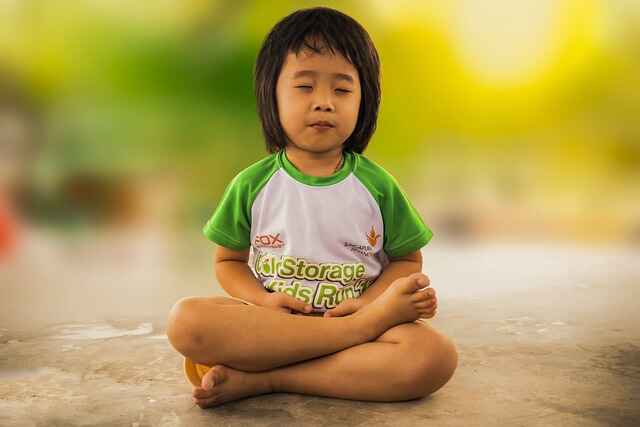Yoga is a practice that offers numerous benefits to people of all ages, including children. It helps them develop strength, flexibility, balance, and concentration while also promoting relaxation and overall well-being. Introducing yoga to children at an early age can be incredibly beneficial as it instills healthy habits and fosters a positive relationship with physical activity. Let’s explore 15 yoga poses for children along with step-by-step instructions and the incredible benefits they offer.
Also, Read 10 Science-Proven Health Benefits of Yoga!
1. Mountain Pose (Tadasana):
- – Stand tall with feet hip-width apart.
- – Arms relaxed by the sides, palms facing forward.
- – Benefits: Improves posture, balance, and focus.
2. Tree Pose (Vrksasana):
- – Shift weight onto one leg, and place the opposite foot on the inner thigh or calf.
- – Bring hands together at the chest.
- – Benefits: Enhances balance, and concentration, and strengthens leg muscles.
3. Cat-Cow Pose (Marjaryasana-Bitilasana):
- – Start on all fours with hands under shoulders and knees under hips.
- – Arch the back upwards (cow pose) and then lower it downwards (cat pose).
- – Benefits: Improves spinal flexibility and coordination.
4. Downward-Facing Dog Pose (Adho Mukha Svanasana):
- – Begin on all fours, then lift hips and straighten legs, forming an inverted V shape.
- – Press palms into the ground and relax the neck.
- – Benefits: Stretches the entire body, strengthens arms and legs, and calms the mind.
5. Butterfly Pose (Baddha Konasana):
- – Sit on the floor, bring the soles of the feet together, and let the knees fall to the sides.
- – Hold onto the feet or ankles and gently flap the legs like butterfly wings.
- – Benefits: Stretches inner thighs, opens hips, and promotes relaxation.
6. Child’s Pose (Balasana):
- – Kneel on the floor, sit back on the heels, and lower the upper body forward, resting the forehead on the mat.
- – Extend arms in front or alongside the body.
- – Benefits: Relaxes the body and mind, stretches the back, and relieves stress.

7. Cobra Pose (Bhujangasana):
- – Lie face-down, place palms near the shoulders, and lift the upper body, keeping the lower body grounded.
- – Look upwards while keeping the shoulders relaxed.
- – Benefits: Strengthens the back and core, opens the chest, and improves posture.
8. Bridge Pose (Setu Bandhasana):
- – Lie on the back, bend the knees, and place feet hip-width apart.
- – Lift the hips off the ground, pressing through the feet and shoulders.
- – Benefits: Stretches the chest, spine, and hips, improves digestion, and boosts energy.
9. Warrior Pose (Virabhadrasana):
- – Step one foot forward into a lunge position, keeping the knee directly above the ankle.
- – Extend the opposite leg behind, with the foot turned slightly outward.
- – Raise arms parallel to the ground, and gaze forward.
- – Benefits: Builds strength in the legs, stretches the hips and promotes confidence.
10. Happy Baby Pose (Ananda Balasana):
- – Lie on the back, bend the knees, and grab the outer edges of the feet.
- – Gently pull the knees towards the armpits while keeping the spine relaxed.
- – Benefits: Stretches the hips, and inner thighs, and relieves lower back tension.
11. Standing Forward Bend (Uttanasana):
- – Stand with feet hip-width apart, hinge at the hips, and fold forward, reaching for the floor or legs.
- – Let the head hang heavy and relax the neck
- – Benefits: Relieves tension in the hamstrings, stretches the spine and calms the mind.
12. Dolphin Pose (Ardha Pincha Mayurasana):
- – Begin on all fours, lower forearms to the ground, and lift hips towards the ceiling.
- – Press forearms into the mat, lengthen the spine, and relax the neck.
- – Benefits: Strengthens the arms and shoulders, stretches the hamstrings, and improves focus.
13. Airplane Pose (Deergha Natarajasana):
- – Stand tall, extend one leg back while leaning the upper body forward, balancing on one leg.
- – Extend arms out to the sides or in front, finding balance.
- – Benefits: Enhances balance, leg strength, and concentration.
14. Boat Pose (Navasana):
- – Sit on the mat, lean back slightly, lift the legs off the ground, and balance on the sitting bones.
- – Extend arms forward or keep them alongside the body.
- – Benefits: Strengthens the core muscles, improves digestion, and stimulates the kidneys.
15. Corpse Pose (Savasana):
- – Lie flat on the back, legs slightly apart, and arms relaxed by the sides.
- – Close the eyes and focus on deep, slow breathing, allowing the body to completely relax.
- – Benefits: Promotes deep relaxation, reduces stress and anxiety, and enhances overall well-being.
Introducing yoga to children not only cultivates physical strength, flexibility, and balance but also nurtures their mental and emotional well-being. These 15 yoga poses offer a wide range of benefits from improving concentration and coordination to reducing stress and promoting relaxation.

So gather your little ones, roll out the yoga mats, and embark on a journey of physical and mental well-being together. Let yoga be a shared experience that not only strengthens the bond between parents and children but also sets the foundation for a lifetime of health and happiness!
Also, Read 10 Breathing Exercises For a Healthy Body & Stress-Free Mind





